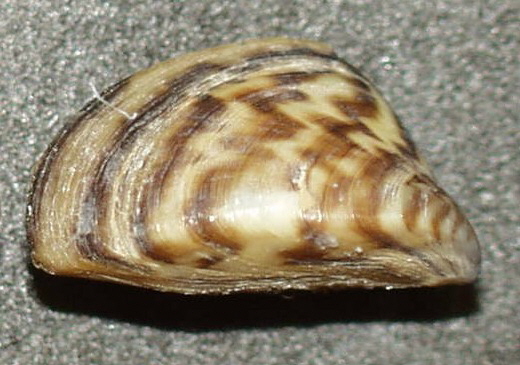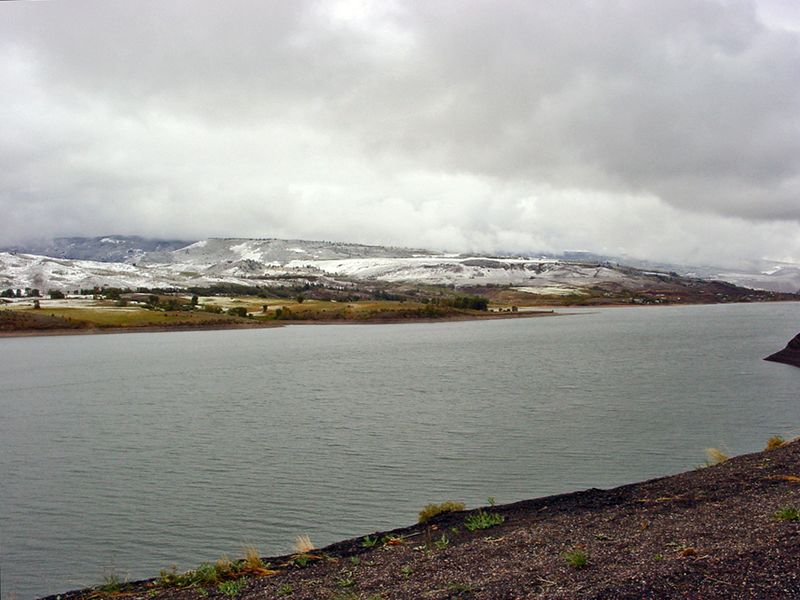Aquatic nuisance species (ANS), plants and animals that invade lakes, reservoirs, rivers and streams, pose an increasing threat to Colorado’s water resources. The major threat is from zebra and quagga mussels invading water bodies across the state. Other nuisance species include New Zealand mudsnails and rusty crayfish. Colorado Parks and Wildlife has an inspection protocol in place since 2009 that has prevented the establishment and spread of ANS. The challenge is to develop stable annual funding sources to sustain the successful Colorado inspection program which has set the standard in the West for prevention of these invasives.
Mussels are small yet mighty. They can pose a threat to native aquatic life as they are tougher and will outcompete native species for necessary resources such as shelter, food and water. This causes a decrease in biodiversity, especially since these invasive species don’t have predators to keep them in check once they get established. Mussels pose a challenge to our built environment as well. Mussel species will grow on hard surfaces like rocks, floating wood, water intake pipes and hydropower plants—multiplying until they eventually clog the intake pipe. This will greatly reduce the amount of water a municipality can deliver, substantially increase maintenance costs which will require a steep increase in water pricing.
Colorado had some close calls as the inspection program was being planned in 2008 and established by legislation in 2009. Zebra and quagga mussel larvae known as “Veligers” were found in Blue Mesa, Pueblo and Granby reservoirs, but thanks to the monitoring and early detection by Colorado Parks and Wildlife, and proactive follow-up with the inspection program, these reservoirs are now clean with no adult mussel establishment. In August 2017, after a long period of no evidence of mussels in Colorado, quagga larvae were found in Green Mountain Reservoir. Officials running the Colorado Parks and Wildlife Inspection Program believe there is a good chance that early detection and proactive tightening of inspections at Green Mountain will prevent the mussels from getting established as was the case with Pueblo, Blue Mesa and Granby Reservoirs.
So, how do mussels invade in the first place? The larvae know as Veligers are transported in contained water such as ballasts, bait wells, and engines, including jet skis. Since mussels grow on hard surfaces, boats and boat trailers make for a great location for larvae to grow into adults. If the boat is not inspected and cleaned, drained and dried properly, the larvae will live on and adult mussels will stay attached. When a contaminated boat is launched into a different lake or reservoir, the larvae can spread to that lake and establish a mussel population. ANS spread easily and wreak havoc on our water systems, so some states have devised strategies to minimize and contain the impact of these invasives. Once adult mussels are established there is no known way of removing them.
Take Lake Powell for example. Anyone who has visited Lake Powell recently can see mussels clinging to canyon walls and mussel shells littering the beach. The cost of operating the reservoir has been increased substantially by the intensive maintenance needed to keep pipes, grates and power plants from clogging with mussels.
Colorado passed the State Aquatic Nuisance Species Act in May 2008. The act makes it illegal to possess, import, export, transport, release, plant, place, or cause an ANS to be released. It also provided funding to Colorado Parks and Wildlife. Following the State Aquatic Nuisance Species Act, Colorado Parks and Wildlife passed new rules in 2009 requiring that all boats coming into the state be inspected, and any boat leaving contaminated waters be inspected—ANS-infested boats must be decontaminated when necessary. There are approximately 72 boat inspection and decontamination stations that are operated by state, local, federal and private entities. These stations have stopped more than 100 infested boats from entering Colorado’s waters. In addition to these rules, Colorado Parks and Wildlife is always conducting research related to the prevention and control of ANS.
Funding enables the prevention and management of ANS. According to Doug Vilsack, legislative liaison for Colorado Parks and Wildlife, most of the initial funding for ANS came from the tier 2 severance tax from the Department of Natural Resources (DNR) that was leftover from other projects or programs. However, in 2016 that money was no longer available so other funds had to be sourced. “It takes about $4.8 million to operate inspection stations and boat ramps that need to open in April 2018,” Vilsack says. However, there are some alternatives that are being considered in the most recent draft bill. One of them is an ANS stamp, which will cost $25 for in-state boaters and $50 for out-of-state boaters. But Colorado Parks and Wildlife is also hoping to crack down on violators by increasing fines for those who forgo inspection and import ANS from other states. “ANS really does impact people throughout the state,” Vilsack says.

Mussels can out compete native species for resources, which will decrease the amount of biodiversity in the ecosystem. Photo courtesy of the USGS.
So what has stood in the way of funding for ANS? There are multiple factors that play into this. According to Emily Brumit, who works in the Government Affairs section of Colorado Water Congress, past legislation for ANS came as part of a larger funding bill that was introduced at the last part of the most recent legislative session. “The understanding of constituents as to why ANS is important is an issue…It was hard to single out of the larger bill,” says Brumit. State residents who enjoy the recreational boating activities provided by Colorado’s lakes and reservoirs voiced their opinion saying that the increase in fee seemed unfair as boating is a way they spend time with their families. Some felt that it simply didn’t make sense. “There is little basic education about why ANS threaten the very activities they enjoy,” Brumit says.
“Those of us operating at-risk reservoirs were facing a crisis going into 2017 with no new tier 2 Severance taxes which had been used to fund the inspection program,” says Michael Preston, General Manager of the Dolores Water Conservancy District (DWCD). DWCD operates McPhee Reservoir, the second largest reservoir in Colorado, located within a few hours of Lake Powell. “Thankfully, the State Legislature stepped up with $3.6 million to keep the inspections going with SB 16-259. This appropriation combined with carryover from previously allocated severance taxes, and $335,000 in partner contributions provided enough funding to keep the inspection program funded through 2018,” Preston says.
“We need to go into the future knowing that stable funding will be in place. The cost of losing the battle with mussels would drive up water costs for everyone in Colorado. We wholeheartedly support the ANS stamp on in-state and out-of-state boater registrations estimated to generate $2.5 million toward the $4.8 million annual cost of the inspection program,” Preston says. “If we can increase federal funds coming into the inspection program, and local partners continue to provide match, it is still going to take a recovery of severance taxes to fully fund the program. It is our hope that the return of Tier 2 Severance Tax revenues can be used to build, at minimum, a one-year reserve, so we never find ourselves faced with the risks that had everyone scrambling to salvage the 2017 inspection program.”


 Print
Print
Reblogged this on Coyote Gulch.